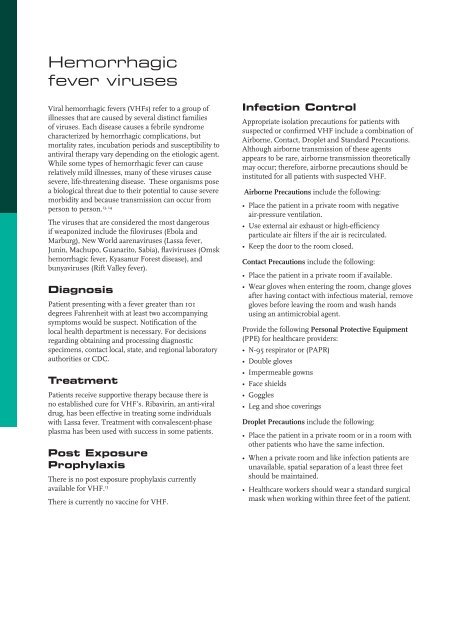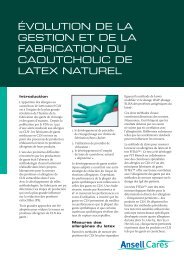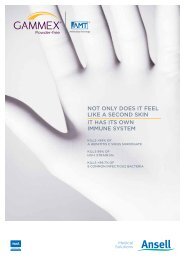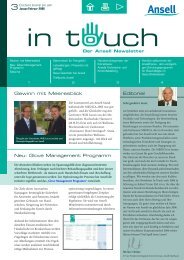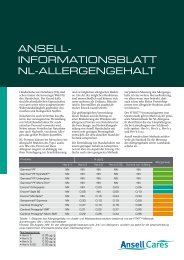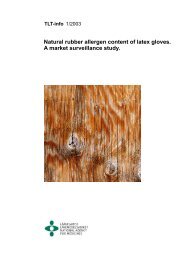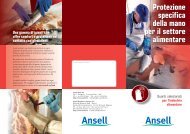Download full document (pdf) - Ansell Healthcare Europe
Download full document (pdf) - Ansell Healthcare Europe
Download full document (pdf) - Ansell Healthcare Europe
You also want an ePaper? Increase the reach of your titles
YUMPU automatically turns print PDFs into web optimized ePapers that Google loves.
Hemorrhagic<br />
fever viruses<br />
Viral hemorrhagic fevers (VHFs) refer to a group of<br />
illnesses that are caused by several distinct families<br />
of viruses. Each disease causes a febrile syndrome<br />
characterized by hemorrhagic complications, but<br />
mortality rates, incubation periods and susceptibility to<br />
antiviral therapy vary depending on the etiologic agent.<br />
While some types of hemorrhagic fever can cause<br />
relatively mild illnesses, many of these viruses cause<br />
severe, life-threatening disease. These organisms pose<br />
a biological threat due to their potential to cause severe<br />
morbidity and because transmission can occur from<br />
13, 14<br />
person to person.<br />
The viruses that are considered the most dangerous<br />
if weaponized include the filoviruses (Ebola and<br />
Marburg), New World aarenaviruses (Lassa fever,<br />
Junin, Machupo, Guanarito, Sabia), flaviviruses (Omsk<br />
hemorrhagic fever, Kyasanur Forest disease), and<br />
bunyaviruses (Rift Valley fever).<br />
Diagnosis<br />
Patient presenting with a fever greater than 101<br />
degrees Fahrenheit with at least two accompanying<br />
symptoms would be suspect. Notification of the<br />
local health department is necessary. For decisions<br />
regarding obtaining and processing diagnostic<br />
specimens, contact local, state, and regional laboratory<br />
authorities or CDC.<br />
Treatment<br />
Patients receive supportive therapy because there is<br />
no established cure for VHF’s. Ribavirin, an anti-viral<br />
drug, has been effective in treating some individuals<br />
with Lassa fever. Treatment with convalescent-phase<br />
plasma has been used with success in some patients.<br />
Post Exposure<br />
Prophylaxis<br />
There is no post exposure prophylaxis currently<br />
available for VHF. 13<br />
There is currently no vaccine for VHF.<br />
Infection Control<br />
Appropriate isolation precautions for patients with<br />
suspected or confirmed VHF include a combination of<br />
Airborne, Contact, Droplet and Standard Precautions.<br />
Although airborne transmission of these agents<br />
appears to be rare, airborne transmission theoretically<br />
may occur; therefore, airborne precautions should be<br />
instituted for all patients with suspected VHF.<br />
Airborne Precautions include the following:<br />
• Place the patient in a private room with negative<br />
air-pressure ventilation.<br />
• Use external air exhaust or high-efficiency<br />
particulate air filters if the air is recirculated.<br />
• Keep the door to the room closed.<br />
Contact Precautions include the following:<br />
• Place the patient in a private room if available.<br />
• Wear gloves when entering the room, change gloves<br />
after having contact with infectious material, remove<br />
gloves before leaving the room and wash hands<br />
using an antimicrobial agent.<br />
Provide the following Personal Protective Equipment<br />
(PPE) for healthcare providers:<br />
• N-95 respirator or (PAPR)<br />
• Double gloves<br />
• Impermeable gowns<br />
• Face shields<br />
• Goggles<br />
• Leg and shoe coverings<br />
Droplet Precautions include the following:<br />
• Place the patient in a private room or in a room with<br />
other patients who have the same infection.<br />
• When a private room and like infection patients are<br />
unavailable, spatial separation of a least three feet<br />
should be maintained.<br />
• <strong>Healthcare</strong> workers should wear a standard surgical<br />
mask when working within three feet of the patient.


